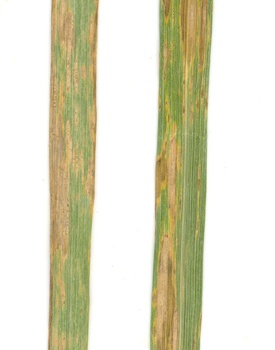Diseases
Septoria oryzae Catt. - Septoria Leaf Spot
Systematic position.
Division Deuteromycotina, class Coelomycetes, order Sphaeropsidales, family Sphaerioidaceae, genus Septoria.Biological group.
This disease is a Hemibiotrophic parasite.Morphology and biology.
Pycnidia are numerous and black, with stoma, 80-120 microns. Spores are cylindrical, direct or curved, with 3-4 septa, 15-23 (50) x 2-3.5 microns. The spots on leaves, sheathes, spike scales, and seeds are brownish-gray, located linearly between ribs, densely covered with pycnidia. The spots can merge, causing leaf loss. During strong infection the plant dries up. Pycnidia over winter on infected residues and seeds. During the vegetation period the infection is carried by spores.Ecology.
The disease development favors wet, windy weather and heavy rains.Distribution.
Disease is found everywhere throughout the zones of rice cultivation.Economic significance.
Strong development of the disease can cause yield losses to 10%. Control measures include careful removal of residues, early autumn plowing of soil, fungicide treatment of seeds before sowing.Reference citations:
Ainsworth G.C. 1971. Dictionary of the fungi. Kew, Surrey: Commonwealth Mycological Institute. 663 p.Dorofeeva L.L., Kodyakov A.A., Kratenko V.P., Lebedev M.B., Motovilin A.A., Tikhonova N.A. 1992. Fungal diseases of rice. Tashkent: FAN. 94 p. (In Russian)
Egorova L.N., Oksenyuk G.I. 1989. Mycoflora of rice in Primorskii Territory. In: Reifman V.G., Dyakonov K.P., eds. Plant protection in the Far East. Vladivostok: Dalnevostochnoe branch of Academy of Science of SU. 66-71 p. (In Russian)
Peresypkin V.F. 1987. Diseases of rice. In: Peresypkin V.F. Atlas of crop diseases. Kiev: Urozhai. 61-64 p. (In Russian)
Teterevnikova-Babayan D.N. 1987. Fungi of the genus Septoria in the USSR. Yerevan: Academy of Sciences of Armenian SSR. 320 p. (In Russian)
© Gasich E.L.


